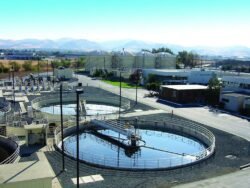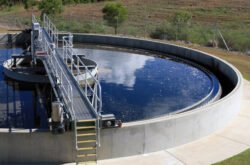
Drum Filters in Wastewater Treatment: Efficient Solids Removal Explained

Drum filters play a crucial role in the wastewater treatment process, providing a mechanical filtration solution that is both effective and reliable. These filters work by trapping solids as wastewater passes through a rotating drum that is covered with a filtering screen or fabric. Designed to handle a wide range of waste streams, drum filters can be found in various applications, from municipal sewage treatment plants to industrial facilities, where the quality of effluent water must be strictly controlled.
The effectiveness of drum filters in wastewater treatment is dependent on their design and operation. They are engineered to facilitate the removal of particulate matter with minimal maintenance and operational costs. Moreover, drum filters are integral components in the protection of downstream processes and in meeting stringent effluent discharge regulations. Their ability to adapt to different wastewater characteristics and flow rates makes them a versatile solution for a multitude of filtration needs.
Key Takeaways
- Drum filters mechanically filter solids from wastewater, aiding in treatment.
- These systems are versatile and suitable for various applications and effluent qualities.
- They contribute to meeting environmental regulations for wastewater discharge.
Principles of Drum Filtration
Drum filters are an integral part of wastewater treatment, designed to remove particulates from water through a mechanical and aeration process. Each filter’s effectiveness in solids handling capacity and filtering precision makes them suitable for a variety of wastewater applications.
Mechanics of Drum Filters
Drum filters operate on a simple mechanical process where wastewater is channeled into a rotating drum covered with a filter cloth or mesh. The drum’s rotation is typically powered by an electric motor, and the speed is adjustable to accommodate different flow rates and solids loads. As the drum rotates, solids are captured on the outer surface of the drum, while the filtrate passes through the mesh into a collection area.
The Filtration Process
When discussing the filtration process, two stages are vital: screening and backwashing. Initially, wastewater flows into the drum, where particulate matter is screened out. The filtered water then exits through the drum’s other side. Over time, the mesh gets clogged with trapped solids, at which point backwashing occurs. Backwashing involves reversing the flow of water to dislodge the trapped solids, usually with a combination of water jets and brushes, to maintain the filter’s efficiency.
Materials and Design
Materials and design play a critical role in the durability and efficiency of drum filters. The mesh or filtering material can vary, typically made of stainless steel or a special composite weave, allowing for effective separation of solids while resisting corrosion. The overall design, including the drum size and motor strength, is tailored to a plant’s specific needs, allowing for handling of various solids loading rates and compatibility with subsequent treatment processes.
Applications in Wastewater Treatment
Drum filters play a crucial role in the removal of solids from wastewater across various applications, ensuring efficient and reliable treatment processes.
Industrial Wastewater Treatment
In the context of industrial wastewater treatment, drum filters are employed to separate particulate matter from industrial effluents. They serve industries ranging from food processing to chemical manufacturing, where they are pivotal in treating water before it is either reused or discharged. The robust design of the drum filters allows them to handle high volumes of wastewater, containing various kinds of solids, without compromising the efficiency of filtration.
Municipal Wastewater Management
For municipal wastewater management, drum filters are essential in protecting sensitive downstream treatment units such as biological reactors. They provide preliminary treatment by capturing large solids which, if not removed, could harm the infrastructure and reduce the operational efficiency of the treatment plants. Effective solids removal by drum filters can also significantly reduce the burden on secondary treatment processes.
Aquaculture Systems
In aquaculture systems, maintaining water quality is paramount for the health of aquatic life. Drum filters are utilized to eliminate organic waste materials and suspended solids from water, making them safe for fish and other marine species. This type of filtration system is key to sustaining an environment conducive to growth and reducing the load on biological treatment stages.
Performance Considerations
In assessing the role of drum filters in wastewater treatment, attention must be focused on filter efficiency, operational parameters, and maintenance and durability to ensure optimal performance and longevity.
Filter Efficiency
Drum filters are designed to remove particulates from wastewater with high efficiency. Their effectiveness is often measured by the quality of effluent water, where lower concentrations of Total Suspended Solids (TSS) indicate better performance. A rotary drum screen’s ability to produce a consistently clear effluent is a crucial metric of its effectiveness in wastewater management.
Operational Parameters
The operation of drum filters is governed by several critical parameters, such as flow rate and loading rate. These parameters must be carefully calibrated to match the specific requirements of the wastewater treatment facility. For example, flow rates of drum filters can range from 0.01 to 0.04 liters per square meter-second, impacting the overall treatment capacity.
Maintenance and Durability
Regular maintenance is paramount to sustain the performance and extend the life of drum filters. Components such as the drive mechanism and screening material should be regularly inspected for wear and tear. Durable materials and robust design contribute to the long-term reliability of drum filters, which is essential for continuous operation in wastewater treatment facilities. Maintenance costs, which vary depending on the technology, can range from moderate to high, but they are a necessary investment for the upkeep of such systems.
Installation and Implementation
The installation and implementation of drum filters in wastewater treatment necessitate careful planning. These stages are crucial for ensuring efficiency, cost-effectiveness, and compliance with environmental regulations.
Sizing and Capacity
Sizing is a primary consideration for drum filters, as it directly impacts the filter’s ability to cope with the wastewater flow rates. For effective sizing, engineers must evaluate the maximum anticipated solids loading and the hydraulic throughput of the plant. Capacity must also account for peak flow conditions to avoid system overload, ensuring the drum filter operates within its designed parameters.
Integration Into Wastewater Systems
Integration of drum filters into existing wastewater treatment systems requires a thorough assessment of compatibility. The design of the inflow and outflow connections, support structures, and access for maintenance are essential. Drum filters must be seamlessly connected to ensure that the treated water meets the required quality standards and that the filtration process does not impede overall system performance.
Cost Factors
Finally, the cost factors associated with the installation of drum filters encompass more than the initial purchase price. Capital expenses such as civil works and retrofitting, operational costs like energy consumption and maintenance, and potential costs from downtime or regulatory non-compliance all contribute to the economic assessment of the installation. Balanced cost management ensures the long-term viability of the drum filter’s operation within the wastewater treatment framework.
Regulatory Standards and Environmental Impact
Drum filters are essential in wastewater treatment, significantly impacting amenity through adherence to environmental regulations and contributing to sustainable operations.
Compliance With Regulations
Drum filters in wastewater treatment are subject to stringent regulatory standards which ensure the protection of water quality. Systems like Effluent Guidelines established by the US Environmental Protection Agency mandate specific requirements that wastewater must meet before discharge into surface waters or municipal sewage plants. They have to efficiently remove solids and organic matter to prevent contamination. Non-compliance can lead to legal repercussions and financial penalties.
Sustainability and Eco-Friendliness
The environmental impact of drum filters operates on the principle of sustainability. They must function not just effectively, but also efficiently, minimizing waste and energy consumption. The design and operation of drum filters advance eco-friendly practices, as they conserve water by allowing for the possibility of water reuse once contaminants have been effectively removed. Moreover, by preserving aquatic ecosystems, they contribute positively to the overall health of the environment.
Innovations and Future Prospects
Recent advancements in drum filter technology have focused on enhancing the efficiency and reliability of wastewater treatment processes. Drum filters are used to remove fine solids, thereby reducing the load on subsequent treatment stages. Innovations in this area are crucial for improving water quality and conservation.
Design Improvements: Modern drum filters now feature more robust construction and improved materials to extend service life and reduce maintenance costs. They are engineered with finer screens to capture smaller particles, thus providing cleaner effluent.
Automation and Control Systems: Automated control systems have been integrated with drum filters to optimize performance. Sensors and software are utilized to adjust filtration rates, monitor filter health, and anticipate maintenance needs, resulting in more consistent treatment outcomes and operational cost savings.
Energy Efficiency: In the pursuit of sustainability, energy-efficient drum filters are being developed. These systems aim to reduce power consumption by applying advanced motor technologies and optimizing filtration processes.
Scalability and Modularity: To accommodate varying wastewater treatment demands, drum filters are being designed with scalability in mind. Modular systems allow for easy expansion and customization, enabling facilities to adapt to changing treatment capacities.
Multistage Filtration Systems: There is a growing trend towards combining drum filters with other treatment technologies, such as membrane filtration, to create multistage systems that enhance removal efficiency. This hybrid approach is particularly effective in reducing the concentration of nutrients and emerging pollutants in wastewater.
The future of drum filters lies in continuous innovation, aimed at improving removal performance, ensuring cost-effectiveness, and addressing a broader spectrum of contaminants. This trajectory is supported by ongoing research and development in materials science, automation, and system design.
Frequently Asked Questions
How do rotary drum filters function in wastewater treatment processes?
Rotary drum filters in wastewater treatment work by rotating a drum covered with a filtering medium through the water to be treated. As water passes through the filter, suspended solids are captured on the drum's surface, while the cleaned water exits the system.
What contaminants are removed by drum filters in wastewater treatment systems?
Drum filters are designed to remove particulate matter, which includes organic and inorganic solids. Their primary function is to filter out suspended solids, such as grit, algae, and other fine particles from the wastewater.
What are the maintenance requirements for drum filters used in wastewater management?
Maintenance for drum filters usually involves regular inspection and cleaning of the filter media to prevent clogging and ensure optimal performance. Components such as seals and bearings also require periodic checks and replacement as necessary.
How does a drum screen filter differ from other types of drum filters in wastewater treatment?
A drum screen filter specializes in removing larger solids through a screening process, whereas other drum filters might use finer media to remove smaller particles. The key difference lies in the size of the openings in the filter media, determining the size of particles removed.
What role does a rotary drum thickener play in wastewater treatment?
A rotary drum thickener is used to concentrate sludge by separating water from the solids. This process enhances the efficiency of subsequent treatment stages by reducing sludge volume and optimizing the performance of dewatering equipment.


